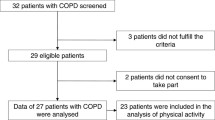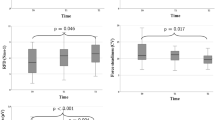Abstract
Purpose
Upper extremities play an important role in performing of many activities of daily living. Physical and pathological changes limit upper extremity functions in older adults with chronic obstructive pulmonary disease (COPD). Although the 6-minute pegboard and ring test (6PBRT) is a reliable and commonly used method for the assessment of unsupported upper-extremity exercise capacity in patients with COPD, there is lack of evidence about the possible determinants of the 6PBRT score. The study aimed to investigate the possible determinants of the 6PBRT in older adults with COPD.
Methods
Fifty-two older adults (age ≥ 65 years) with stable COPD and 23 age-matched healthy older adults participated in this study. Demographic characteristics, unsupported upper-extremity exercise capacity, pulmonary function, functional exercise capacity, disease related symptoms, peripheral and respiratory muscle strength were evaluated. Stepwise multiple linear regression analysis was used to investigate the possible determinants of the 6PBRT score.
Results
The 6PBRT score was significantly higher in healthy participants compared with those with COPD (p = 0.024). In participants with COPD, shoulder flexor muscle strength, age and functional exercise capacity were significant and independent predictors of the unsupported upper-extremity exercise capacity with explaining 55.4% of the variance.
Conclusions
This study suggests that shoulder flexor muscle strength, age and functional exercise capacity are independent determinants of the unsupported upper-extremity exercise capacity assessed by the 6PBRT in older adults with COPD.

Similar content being viewed by others
References
GOLD. Global Initiative for Chronic Obstructive Lung Disease (2018) Global strategy for the diagnosis, management, and prevention of chronic obstructive pulmonary disease. https://goldcopd.org. Accessed 20 Jul 2018
Incalzi RA, Scarlata S, Pennazza G, Santonico M, Pedone C (2014) Chronic obstructive pulmonary disease in the elderly. Eur J Intern Med 25(4):320–328. https://doi.org/10.1016/j.ejim.2013.10.001
Kobayashi S, Yanai M, Hanagama M, Yamanda S (2014) Burden of chronic obstructive pulmonary disease in the elderly population. Respir Investig 52(5):296–301. https://doi.org/10.1016/j.resinv.2014.04.005
Fried TR, Vaz Fragoso CA, Rabow MW (2012) Caring for the older person with chronic obstructive pulmonary disease. JAMA 308(12):1254–1263. https://doi.org/10.1001/jama.2012.12422
Kutukcu EÇ, Arikan H, Sağlam M, Yagli NY, Oksüz Ç, Ince Dİ et al (2015) A comparison of activities of daily living in geriatric and non-geriatric patients with chronic obstructive pulmonary disease. Turk J Geriatr 18(1):68–74
Pendleton HM, Schultz-Krohn W (2012) Pedretti’s occupational therapy: practice skills for physical dysfunction, 7th edn. Mosby, pp 157–162
Saboisky JP, Gorman RB, De Troyer A, Gandevia SC, Butler JE (2007) Differential activation among five human inspiratory motoneuron pools during tidal breathing. J Appl Physiol (1985) 102(2):772–780. https://doi.org/10.1152/japplphysiol.00683.2006
Costi S, Crisafulli E, Degli Antoni F, Beneventi C, Fabbri LM, Clini EM (2009) Effects of unsupported upper extremity exercise training in patients with COPD: a randomized clinical trial. Chest 136(2):387–395
Spruit MA, Singh SJ, Garvey C, ZuWallack R, Nici L, Rochester C et al (2013) An official American Thoracic Society/European Respiratory Society statement: key concepts and advances in pulmonary rehabilitation. Am J Respir Crit Care Med 188(8):e13–e64
Janaudis-Ferreira T, Hill K, Goldstein RS, Robles-Ribeiro P, Beauchamp MK, Dolmage TE et al (2011) Resistance arm training in patients with COPD: a randomized controlled trial. Chest 139(1):151–158
Zhan S, Cerny FJ, Gibbons WJ, Mador MJ, Wu YW (2006) Development of an unsupported arm exercise test in patients with chronic obstructive pulmonary disease. J Cardiopulm Rehabil 26(3):180–187 (discussion 8–90)
Ranu H, Wilde M, Madden B (2011) Pulmonary function tests. Ulster Med J 80(2):84–90
Perez T, Burgel PR, Paillasseur JL, Caillaud D, Deslee G, Chanez P et al (2015) Modified Medical Research Council scale vs Baseline Dyspnea Index to evaluate dyspnea in chronic obstructive pulmonary disease. Int J Chron Obstruct Pulmon Dis 10:1663–1672. https://doi.org/10.2147/copd.s82408
Neder JA, Andreoni S, Lerario MC, Nery LE (1999) Reference values for lung function tests. II. Maximal respiratory pressures and voluntary ventilation. Braz J Med Biol Res 32(6):719–727
Leggin BG, Neuman RM, Iannotti JP, Williams GR, Thompson EC (1996) Intrarater and interrater reliability of three isometric dynamometers in assessing shoulder strength. J Shoulder Elbow Surg 5(1):18–24
Shechtman O, Gestewitz L, Kimble C (2005) Reliability and validity of the DynEx dynamometer. J Hand Ther 18(3):339–347. https://doi.org/10.1197/j.jht.2005.04.002
American Thoracic Society (2002) ATS statement: guidelines for the six-minute walk test. Am J Respir Crit Care Med 166(1):111–117. https://doi.org/10.1164/ajrccm.166.1.at1102
Cohen J (1988) Statistical power analysis for the behavioural sciences, 2nd edn. Routledge, pp 109–116
Criner G (2011) 6-minute walk testing in COPD: is it reproducible? Eur Respir J 38(2):244–245. https://doi.org/10.1183/09031936.00023011
Skeletal muscle dysfunction in chronic obstructive pulmonary disease (1999) A statement of the American Thoracic Society and European Respiratory Society. Am J Respir Crit Care Med 159(4 Pt 2):S1–S40. https://doi.org/10.1164/ajrccm.159.supplement_1.99titlepage
van Eeden SF, Yeung A, Quinlam K, Hogg JC (2005) Systemic response to ambient particulate matter: relevance to chronic obstructive pulmonary disease. Proc Am Thorac Soc 2(1):61–67. https://doi.org/10.1513/pats.200406-035MS
Pepin V, Saey D, Laviolette L, Maltais F (2007) Exercise capacity in chronic obstructive pulmonary disease: mechanisms of limitation. Copd 4(3):195–204. https://doi.org/10.1080/15412550701480489
Shah S, Nahar P, Vaidya S, Salvi S (2013) Upper limb muscle strength & endurance in chronic obstructive pulmonary disease. Indian J Med Res 138(4):492–496
McKeough ZJ, Velloso M, Lima VP, Alison JA (2016) Upper limb exercise training for COPD. Cochrane Database Syst Rev 11:CD011434. https://doi.org/10.1002/14651858.cd011434.pub2
Lowery EM, Brubaker AL, Kuhlmann E, Kovacs EJ (2013) The aging lung. Clin Interv Aging 8:1489–1496. https://doi.org/10.2147/cia.s51152
Akerman JP, Heckman GA, McKelvie RS (2015) Exercise capacity and aging. Am J Lifestyle Med 9(4):252–265
Ozsoy I, Savci S, Ozsoy G, Acar S, Ozalevli S, Akkoclu A (2015) Exercise capacity and muscle strength influences in geriatric individuals with COPD. Eur Respir J 46:PA974. https://doi.org/10.1183/13993003.congress-2015.pa974
Holland AE, Spruit MA, Troosters T, Puhan MA, Pepin V, Saey D et al (2014) An official European Respiratory Society/American Thoracic Society technical standard: field walking tests in chronic respiratory disease. Eur Respir J 44(6):1428–1446. https://doi.org/10.1183/09031936.00150314
McKenzie DK, Butler JE, Gandevia SC (2009) Respiratory muscle function and activation in chronic obstructive pulmonary disease. J Appl Physiol (1985) 107(2):621–629. https://doi.org/10.1152/japplphysiol.00163.2009
Barreiro E, Gea J (2015) Respiratory and limb muscle dysfunction in COPD. COPD 12(4):413–426
Miller MR (2010) Structural and physiological age-associated changes in aging lungs. Semin Respir Crit Care Med 31(5):521–527. https://doi.org/10.1055/s-0030-1265893
Miner B, Tinetti ME, Van Ness PH, Han L, Leo-Summers L, Newman AB et al (2016) Dyspnea in community-dwelling older persons: a multifactorial geriatric health condition. J Am Geriatr Soc 64(10):2042–2050. https://doi.org/10.1111/jgs.14290
Ho SF, O’Mahony MS, Steward JA, Breay P, Buchalter M, Burr ML (2001) Dyspnoea and quality of life in older people at home. Age Ageing 30(2):155–159
Celli BR, Cote CG, Marin JM, Casanova C, Montes de Oca M, Mendez RA et al (2004) The body-mass index, airflow obstruction, dyspnea, and exercise capacity index in chronic obstructive pulmonary disease. N Engl J Med 350(10):1005–1012. https://doi.org/10.1056/NEJMoa021322
Babb TG, Viggiano R, Hurley B, Staats B, Rodarte JR (1991) Effect of mild-to-moderate airflow limitation on exercise capacity. J Appl Physiol (1985) 70(1):223–230
Takeda K, Kawasaki Y, Yoshida K, Nishida Y, Harada T, Yamaguchi K et al (2013) The 6-minute pegboard and ring test is correlated with upper extremity activity of daily living in chronic obstructive pulmonary disease. Int J Chron Obstruct Pulmon Dis 8:347–351. https://doi.org/10.2147/copd.s45081
Author information
Authors and Affiliations
Corresponding author
Ethics declarations
Conflict of interest
The authors declare that they have no conflict of interest.
Ethical approval
The study was approved by the Ethics Committee of Dokuz Eylül University and all procedures performed in studies involving human participants were in accordance with the 1964 Helsinki declaration and its later amendments or comparamble ethical standards.
Informed consent
All participants gave their informed consent.
Rights and permissions
About this article
Cite this article
Ozsoy, I., Ozcan Kahraman, B., Ozsoy, G. et al. Determinants of the 6-minute pegboard and ring test as an unsupported upper-extremity exercise capacity measure in older adults with chronic obstructive pulmonary disease. Eur Geriatr Med 9, 863–870 (2018). https://doi.org/10.1007/s41999-018-0111-x
Received:
Accepted:
Published:
Issue Date:
DOI: https://doi.org/10.1007/s41999-018-0111-x




